Applications and Benefits of Magnetic Filtration
Oil filtration in automotive and industrial machinery is essential to achieving optimum performance, reliability and longevity. Lubricant cleanliness is highly important and lubrication practitioners are provided with numerous options for filtering and controlling contamination, including disposable filters, cleanable filters, strainers and centrifugal separators. This article discusses the mechanism of particle separation and reviews the many applications of magnetic filters and separators in the lubrication industry today. A brief guide to commercial filtration products is also presented.
From its origin in the beneficiation of iron ores, the magnet has played a prominent role in the separation of ferrous solids from fluid streams. Even in the control of contamination from in-service lubricants and hydraulic fluids, magnetic separation and filtration technology has found a useful niche. Currently, there are a number of conventional and advanced products on the market that employ the use of magnets in various configurations and geometry.
Role of Magnetic Filters
Car owners, car mechanics, equipment operators, maintenance technicians and reliability engineers know the importance of clean oil in achieving machine reliability. Tribologists and used oil analysts are also aware that in some machines as much as 90 percent of all particles suspended in the oil can be ferromagnetic (iron or steel particles). Typically, one or both lubricated sliding or rolling surfaces will have iron or steel metallurgy. These include frictional surfaces in gearing, rolling-element bearings, piston/cylinders, etc.
While it is true that conventional mechanical filters can remove particles in the same size range as magnetic filters, the majority of these filters are disposable and incur a cost for each gram of particles removed. There are other penalties for using conventional filtration, including energy/power consumption due to flow restriction caused by the fine pore-size filter media. As pores become plugged with particles, the restriction increases proportionally, causing the power needed to filter the oil to escalate.
How do Magnetic Filters Work?
While a large number of configurations exist, most magnetic filters work by producing a magnetic field or loading zones that collect magnetic iron and steel particles. Magnets are geometrically arranged to form a magnetic field having a nonuniform flux density (flux density is also referred to as magnetic strength) (Figure 1).
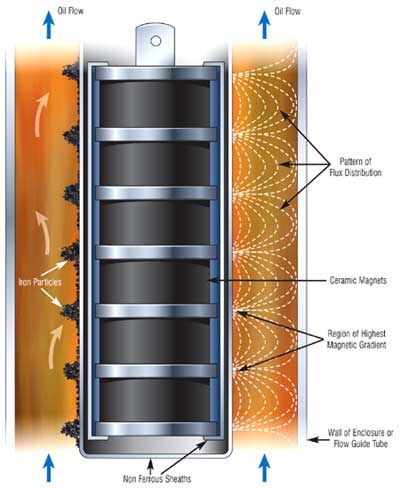
Particles are most effectively separated when there is a strong magnetic gradient (rate of change of field strength with distance) from low to high. In other words, the higher the magnetic gradient, the stronger the attracting magnetic force acting on particles drawing them toward the loading zones. The strength of the magnetic gradient is determined by flux density, spacing and alignment of the magnets.
Various types of magnets can be used in these filters (see sidebar). Magnets used in some filters can have flux density (magnetic strength) as high as 28,000 gauss. Compare this level to an ordinary refrigerator magnet of between 60 and 80 gauss. The higher the flux density, the higher the potential magnetic gradient and magnetic force acting on nearby iron and steel particles.
While there are many configurations of magnetic filters and separators used in process industries, the following are general classifications for common magnetic products used in lubricating oil and hydraulic fluid applications.
Magnetic Plug.
The most basic type of magnetic filter is a drain plug (Figure 2), where a magnet in the shape of a disc or cylinder is attached to its inside surface (typically by adhesion). Periodically, the magnetic plug (mag-plug) is removed and inspected for ferromagnetic particles, which are then wiped from the plug.
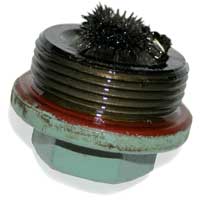
Today, such plugs are commonly used in engine oil pans, gearboxes and occasionally in hydraulic reservoirs. One useful advantage of mag-plugs relates to examining the density of wear particles observed as a visual indication of the wear rate occurring within the machine over a fixed period of running time. The appearance of these iron filings on magnets are often described in inspection reports using terms such as peach fuzz, whiskers or Christmas trees. If one normally sees peach fuzz, but on one occasion sees a Christmas tree instead, this would be a reportable condition requiring further inspection and remediation. After all, abnormal wear produces abnormal amounts of wear debris, leading to an abnormal collection of debris on magnetic plugs.
Spin-on Filter Wraps.
There are several suppliers of magnetic wraps, coils or similar devices intended for use on the exterior of spin-on filter canisters (Figures 7a-c). Spin-on filters are commonly used in the automotive industry but are also utilized in a number of low-pressure industrial applications. These wraps transmit a magnetic field through the steel filter bowl (can) in order for ferromagnetic debris to be held tightly against the internal surface of the bowl, allowing the filter to operate normally while extending the service life. Unlike the conventional filter element, the magnetic filter wrap can be used repeatedly.
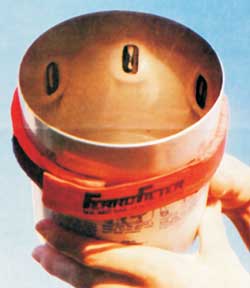
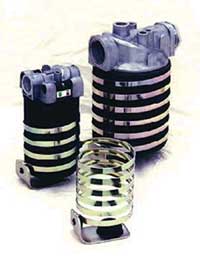
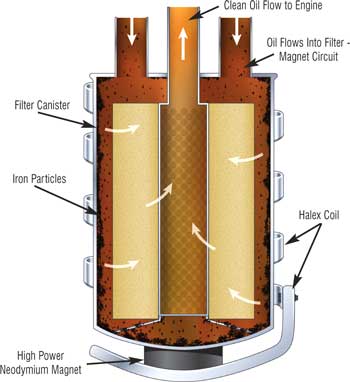
Factors Influencing Magnetic Separating Action
There are a variety of magnets and ways in which magnetic filters and separators can be configured in a product’s design. In fact, there is much more to their performance than simply the strength or gradient of the magnetic field. For instance, the size and design of the flow chamber, total surface area of the magnetic loading zones, and the flow path and residence time of the oil are all important design factors. These factors influence the rate of separation, the size of particles being separated and the total capacity of particles retained by the separator.
The magnetic force acting on a particle is proportional to the volume of the particle, but is disproportional to the diameter of the particle (magnetic force varies with the cube of the particle’s diameter). For instance, a two-micron particle is eight times more attracted to a magnetic field than to a one-micron particle. This means large ferromagnetic particles are disproportionately easier to separate from a fluid compared to smaller particles.
The separating force is proportional to the magnetic field gradient and also to the particle magnetization (magnetic susceptibility). Particle magnetization relates to the degree to which the particle’s material composition is influenced by a magnetic field. The most strongly attracted materials are particles made of iron and steel, however, red iron oxide (rust) and high-alloy steel (for example, stainless steel) are weakly attracted to magnetic fields. Conversely, some nonferrous compounds such as nickel, cobalt and certain ceramics are known to have strong magnetic attraction. Materials that cannot be picked up with a magnet (such as aluminum) are called paramagnetic substances.
There are also competing forces which resist particle separation from the fluid. One such force is oil velocity which imparts inertia and viscous drag on the particle in the direction of the fluid flow. Depending on the design of the magnetic filter, the fluid velocity may send the particle on a trajectory toward or away from the magnetic field or perhaps in a tangential direction.
The competing viscous force is also proportional to both the particle’s diameter and the oil viscosity. If the particle’s diameter or the oil’s viscosity doubles, then the hydrodynamic frictional drag doubles accordingly (resistance to separation). Complicating the situation further, as mentioned above, the magnetic attraction increases by a factor of eight when a particle’s diameter doubles, while the competing viscous drag sees only a 2X multiple. This further emphasizes the fact that larger particles are more easily separated than small particles, even in an environment of considerable viscous drag.
Particle capture efficiency by magnetic technology can be narrowed down to these fundamental factors:
1.Particles that are the easiest to separate are large (100 microns vs. 5 microns) and highly magnetic (for example, iron and low-alloy steel).
2.The fluid conditions that best facilitate the separation of magnetic particles are low oil viscosity (ISO VG 32 vs. ISO VG 320 for instance) and low oil flow rate (2 GPM vs. 50 GPM). Even extremely small, one-micron particles can be separated from the oil if both of these fluid conditions exist concurrently.
3.The most effective magnetic filters employ high-flux magnets and are arranged in such a way that a high-gradient magnetic field develops.
Pros and Cons of Magnetic Filters
The decision to use magnetic technology in a given application depends on various machine conditions and fluid cleanliness objectives. These include the expected concentration of ferrous particles, type of oil used, operating temperature, surge flow and shock and machine design. Because of the numerous commercial products, configurations and applications, certain items on the lists of advantages and disadvantages may not apply. Nonetheless, this list can serve as a starting point for making the decision whether magnetic technology is a good choice in a given application:
Possible Advantages
•Reusable Technology – The cost of removing a gram of particles from the oil with magnetic technology is low compared to disposable filters.
•Limited Flow Restriction – Unlike conventional filters, most magnetic filters exhibit little to no increase in flow restriction (pressure drop) as it loads with particles. While conventional filters can go into bypass when they become plugged with particles, magnetic filters (including mag-plugs and rods) continue to remove particles and allow oil flow. For instance, most diesel and gasoline engines provide no indication of a filter that has gone into bypass. In such cases, the oil may go for an extended period of time without being filtered. Common causes of premature plugging of engine filters include coolant leaks, poor combustion, poor air filtration and overextended oil drains.
•Extended Life of Conventional Filters – When used in conjunction with conventional mechanical filters (Figure 8), an increase in effective filter service life may be experienced. In certain cases, two to three times life extension may be experienced.
•Improved Reliability of Electro- hydraulic Valves – Servovalves and solenoid valves are adversely affected by particles that are magnetic (iron and steel) due to the electromagnets deployed when actuating these valves. The continuous and efficient removal of these particles by magnetic filters can substantially enhance the reliability of these valves.
•Lower Risk of Oil Oxidation – Iron and steel particles are known to promote oil oxidation by their catalytic properties. Premature oil oxidation can lead to varnish, sludge and corrosion. Everything else being equal, the continuous and efficient removal of iron and steel particle by magnetic filters should have a positive impact on oil service life, and over time, reduce oil consumption if oil is changed on condition.
•Enhanced Wear Particle Identification – Traditionally, wear particle identification is performed microscopically by examining particles extracted from oil samples (analytical ferrography). Those particles that have evaded filters have often been reworked (comminution) by traveling through heavily loaded rolling and sliding dynamic machine clearances. Once ground up, crushed and pulverized, they are more difficult to analyze to determine the source location, cause and severity of wear. However, particles removed from mag-plugs, magnetic rods and magnetic filters are often in their original “virgin” state which can greatly enhance the accuracy of machine condition analysis.
•Quick Wear Metal Inspections – Mag-plugs and rods can be removed for visual inspection (daily, weekly, etc.) without stopping the machine or removing a filter. They provide a dual service of contaminant removal and condition monitoring (from the density of wear particles observed).
•Oil Flow Not Required – Many machines are lubricated by oil splash, bath, flingers, slingers and paddles. Without access to a pump and oil flow, conventional onboard filters cannot be used to keep the oil clean and optimize machine reliability (reduce wear) and lubricant service life (reduce oil oxidation). However, magnetic plugs and rods do not require oil to flow in pipes and lines. They require the oil only to agitate and circulate in a sump, reservoir or oil pan. This movement causes these particles to migrate to a loading surface of the magnetic separator.
•Can be Used in Gravity Flow Drain Lines – Most wear metal production comes from the business end of a machine (bearings, gears, cams, etc.). Oil often returns to tank down drain lines and headers (flooded or partially flooded) by gravity. Due to the lack of oil pressure, it is nearly impossible to locate fine filtration on gravity drains to catch wear debris before it enters the reservoir. However, magnetic filters, rods and plugs generally do not restrict flow, enabling these particles to be quickly and conveniently removed directly in oil drains.
Possible Disadvantages
•Detached Particle Agglomerations – A common risk associated with using magnetic separators is the possibility of particles becoming detached from the magnet and washed downstream in mass, potentially entering a sensitive component. This concern is reduced if the magnetic separator is located on a drain line or if a conventional filter is positioned downstream to trap migrating debris. Risk of debris being washed off is highest under surge flow conditions, cold starts, shock, high oil viscosity and/or high oil flow rates.
•Magnetized Transient Particles – Adding to the risk of particle washoff is the chance of these particles becoming magnetized while they were attached to the permanent magnet. After floating downstream, they might adhere magnetically to frictional surfaces such as bearings, causing wear. They could also lodge into narrow flow passages, orifices, glands and oilways, thus restricting flow.
•Nonmagnetic Particles Remain Unchecked – Indeed, magnetic separators will have little effect on controlling nonferrous particles composed of silica, tin, aluminum or bronze. Other types of filters and separators must be used.
•Cleaning Requirement – Unlike conventional filter elements that are thrown away after becoming plugged, magnetic filters are reusable and therefore must be cleaned. The cleaning procedure varies but typically is messy and involves the use of an air hose. Specific cleaning safety precautions must be taken. Magnetic rods and plugs generally need to be wiped clean only at each service interval.
•Separation is not by Size-exclusion Mechanics – As previously discussed, separation is based on physics considerably different from size-exclusion – the method which defines the performance of conventional mechanical filters. Instead, the capture efficiency of magnetic separators is based on many factors including the collective influence of particle size, magnetic susceptibility, flow rate, viscosity and magnetic field gradient.
As such, magnetic filters are not known for having well-defined micronic particle separation capability. Therefore, it is important to determine what micron filter rating is needed by the tribological components in the system, considering the oil viscosity, fluid flow rate through the filter, the properties of the challenge particles, etc. Experience shows that most modern hydraulic components need protection of at least five microns or greater. Studies conducted some 20 years ago at the Fluid Power Research Center at Oklahoma State University for the Office of Naval Research showed that no magnetic filter at that time could satisfy this requirement when used alone. In such cases, the best choice might be a combination of conventional and magnetic filters.
Quote
Types of Magnets
NdFeB (Neodymium-Iron-Boron)
This is the strongest in magnetic strength of all the magnets known to mankind. Neodymium, with a number 60 on the periodic table, was first thought to be a rare earth element, due to its inclusion in the “rare earth” elements between 57 and 71 on the periodic table. NdFeB was first developed and commercialized in the mid 1980s. Over the years, the strength of this composition has increased due to new developments.
SmCo (Samarium Cobalt)
Also being one of the “rare earth” elements, Samarium Cobalt can produce magnetic strength near that of NdFeB. It became available in the 1970s but was rarely used. Due to its expensive composition, fragility and difficulty to manufacture, it is used only for its benefits of being able to withstand high temperatures and corrosion.
Ferrite (Ceramic)
Today’s refrigerator magnet - ceramic magnets with Barium or Strontium Ferrite - is the most common of all magnets. It is considerably inexpensive but it contains a lower strength compared to the other magnets. Developed in the 1960s, it was the “useful” magnet, used everywhere. This type of magnet is cost-effective and resistant to corrosion and demagnetization.
AlNiCo (Aluminum-Nickel-Cobalt)
One of the first magnets developed after plain steel, this magnet has a lower strength rating. It is sensitive to demagnetization and can be destroyed if stored incorrectly or if it comes in contact with Neodymium-Iron-Boron. It has excellent machinability and has about half the strength of a ceramic magnet. Reference: www.wondermagnets.com
Best Applications for Filters and Separators
It is logical that the leading applications for magnetic separators are those where a high percentage of the particle contamination is ferromagnetic and the conditions favor a successful performance of a properly selected and installed magnetic filter or separator. As previously discussed, low oil viscosity combined with low flow rate help to facilitate the separation process (where applicable). It’s a good idea to review the lists of advantages and disadvantages in regards to each application and separator type (mag-plug, rod, flow-through, wrap) considered. Possible uses for magnetic technology include the following:
•Gearboxes (including final drives, differentials, etc.), both forced-circulating and splash-fed
•Large diesel engines, especially where the full-flow filter may prematurely go into bypass without indication
•Any machine with ferrous frictional surfaces but no forced oil circulation with filtration
•Applications where the use of magnetic filters will substantially extend the life of conventional filters already in use
•Applications where iron particles are known to be a major contributor to oil oxidation problems (particularly hot running machines)
•Hydraulic systems, particularly those using electrohydraulic valves
•In situations requiring better precision in recognizing abnormal wear particle generation (and wear particle type)
Many commercial products and suppliers of magnetic technology for contamination control of lubricating oils are listed in the sidebar. Specific questions regarding applications and these products should be directed to these suppliers.
Editor’s Note:
The author wishes to thank his father, Jim C. Fitch and his grandfather, Dr. Ernest C. Fitch, for their help in writing this article.
References:
1.Purslow, Neil. “Advances in Magnetic Oil Filtration.” Diesel Progress, December 2002.
2.Langton, William G. "Removal of Wear Particles from Oils Using High - G gradient Magnetic Separation.” AD-A036 270, MAE Associates, Inc., January 1977. Distributed by NTIS, U.S. Dept. of Commerce.
3.Thoma, Jean. “Magnetic Filter. ” Applied Hydraulics, August 1958.
4.Tyrreil, A.J. “Magnetic Filtration and Separation.” Filtration & Separation, March 1973.
5.Wells, R.M. “Magnetic Filtration in Hydraulic Systems.” IMechE, 1976.
6.Reference material taken from
http://212.240.121.32/new/index.asp (Magnom, Fluid Condition System) June 6, 2005.
7.Reference material taken from www.magneticfiltration.com, May 12, 2004.
8.Hemeon, J.Russell. “Magnetic Plug Assemblies. ” Applied Hydraulics, March 1967.
9.Dickenson, T. Christopher. Filters and Filtration Handbook, 4 th Edition. Elsevier Science Ltd, 1997.
10.Reference material taken from www.lenzinc.com, 1/ June 12 / 2005
11.Reference material taken from www.wondermagnets.com 6/ June 20 / 2004.
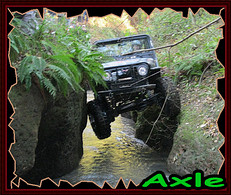
 Help
Help













